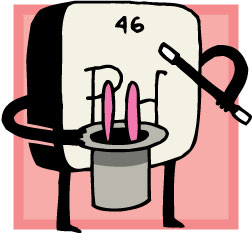Blogging the Periodic Table

Among physicists and chemists, cold fusion—nuclear fusion at close to room temperature—enjoys a reputation about on par with creationism. Cold fusion has always been alluring, however, because if it worked, our world energy shortage would be over. Instantly. It would produce loads of energy from, potentially, nothing but water and leave very little nuclear waste to deal with. But it also tempts people precisely because it's been pronounced impossible so many times—there's no better way to make your name in science than by demonstrating something impossible.
The main reason scientists consider cold fusion unlikely is simple. Fusion involves the conversion of light elements to heavier elements, especially hydrogen to helium. This conversion isn't like turning, say, water or carbon dioxide into something else. Hydrogen and helium are elements—you cannot alter their nature under ordinary circumstances. And by ordinary circumstances, I mean hydrogen fusion in anything short of the conditions inside a star—millions of degrees in temperature, and unthinkably high pressure. Otherwise, two hydrogen atoms just can't be crushed together hard enough to fuse into one helium atom.
Cold fusion is also improbable (at least as an energy source) because it would produce loads of deadly radioactivity. Any scientists near enough to their instruments to get a good reading would almost certainly be fried by radiation. Indeed, one wag has suggested that if a scientist lived long enough to show up for the inevitable press conference announcing his results, that's almost ipso facto proof that, whatever interesting thing he might have done, he didn't induce nuclear fusion.
So why, despite the damning scientific evidence, do people persist in believing in cold fusion? Misguided hope is part of it, certainly. But a better answer comes from the periodic table. There are a few elements—especially platinum and palladium—that have the amazing ability to absorb up to 900 times their own volume in hydrogen gas. To get a sense of the scale there, that's roughly equivalent to a 250-pound man swallowing something the size of a dozen African bull elephants and not gaining an inch on his waistline.
No one knows exactly how these elements pack in hydrogen so tightly—it seems impossible. And that ignorance gives cold fusionists room to maneuver. Their experiments usually involve sending an electric current through water, separating it into oxygen and hydrogen gas. The water also contains a palladium or platinum rod, which starts lapping up the hydrogen. The theory behind cold fusion is that the metal rod somehow crushes the hydrogen gas together by itself, circumventing the inconvenient need for starlike temperatures and pressures. In the most famous claim for cold fusion, in 1989, two University of Utah scientists announced that their modest palladium rod had unleashed so much energy that a flame burned clean through their apparatus, through the lab bench beneath it, and even through the floor beneath that.
Those two scientists first announced their results not in a scientific journal but to the press. And when they did bring their evidence to scientists to evaluate, their colleagues utterly routed their arguments. (Both men ended up leaving the country, disgraced.) But, like some sort of scientific hydra, the field of cold fusion was never quite killed by mainstream scientists. In fact, the attack against the Utah scientists seemed only to cause more heads to sprout. And now, a generation later, the idea of cold fusion has taken hold in people's imaginations once again. The American Chemical Society, the world's largest professional organization of scientists, sponsored multiple sessions on cold fusion at their annual meeting last spring. This drew predictable jeers from the few mainstream scientists still bothering to debunk claims for cold fusion, but the number of such sessions has quadrupled since 2007.
It's a mug's game in science to start declaring things impossible—there's no better way to make yourself look like an ass to posterity. And something funny certainly happens when palladium and platinum come into contact with hydrogen gas; it's one of the great mysteries still waiting to be solved on the periodic table. But it's quite a leap from "something funny" to cold fusion. And most scientists will need a lot more evidence than a quirk to make that leap.